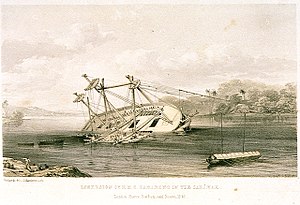HMS Samarang was a 28-gun, teak, Atholl-class sixth rate of the Royal Navy. She was launched at Cochin in 1822 by the East India Company.
 Immersion of HMS Samarang in the Sarawak
| |
| History | |
|---|---|
| Name | HMS Samarang |
| Ordered | 5 June 1819 |
| Builder | Cochin |
| Laid down | March 1821 |
| Launched | 1 January 1822 |
| Completed | By 7 June 1824 |
| Reclassified | Guard ship in May 1847 |
| Fate | Sold in November 1883 |
| General characteristics | |
| Class and type | 28-gun Atholl-class sixth rate |
| Tons burthen | 499 91⁄94 bm (as designed) |
| Length |
|
| Beam | 31 ft 6 in (9.60 m) |
| Sail plan | Full-rigged ship |
| Complement | 175 |
| Armament |
|

The first application of cathodic protection was to HMS Samarang in 1824. Sacrificial anodes made from iron attached to the copper sheathing of the hull below the waterline dramatically reduced the corrosion rate of the copper. However, a side effect of the cathodic protection was to increase marine growth. Copper, when corroding, releases copper ions which have an anti-fouling effect. Since excess marine growth affected the performance of the ship, the Royal Navy decided that it was better to allow the copper to corrode and have the benefit of reduced marine growth, so cathodic protection was not used further.
Samarang served in various stations around the world until seeing action in the First Opium War, and was then employed, under Edward Belcher, in surveying the coasts of the East Indies and southern China from 1843 to 1846.[1] On 17 July 1843, she struck a rock in the Sarawak river at Kuching and capsized, but her crew survived;[2][3][4] she had been refloated by 13 August and was returned to service.[5] English zoologist Arthur Adams, who was assistant surgeon on the ship for this voyage later edited Zoology of the voyage of H.M.S. Samarang (1850), an account of the survey. She later became a guardship at Gibraltar before being sold for breaking in 1883.[6][7][8]
References edit
- ^ Narrative of the Voyage of H.M.S. Samarang during 1843-1846 (1848)
- ^ "Naval Intelligence". The Times. No. 18427. London. 14 October 1843. col E, p. 3.
- ^ "Ship News". The Times. No. 18428. London. 16 October 1843. col A-B, p. 7.
- ^ "Loss of the Samarang Surveying Ship". The Examiner. No. 264. London. 14 October 1843.
- ^ "Shipping Intelligence". Caledonian Mercury. No. 19315. Edinburgh. 11 November 1843.
- ^ "William Loney"
- ^ "Naval database". Archived from the original on 14 June 2011. Retrieved 17 February 2012.
- ^ National Maritime Museum
External links edit
- Media related to HMS Samarang (ship, 1822) at Wikimedia Commons